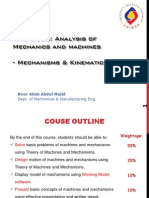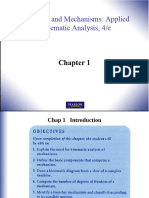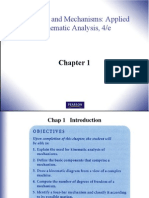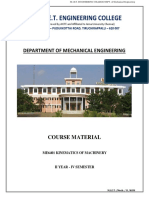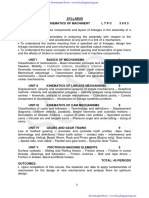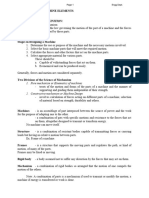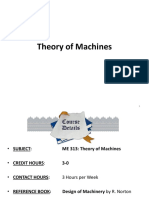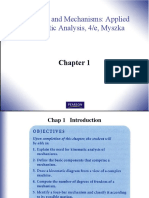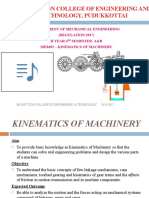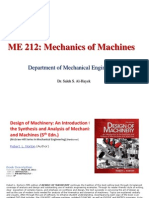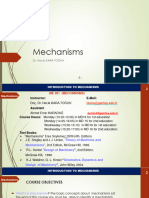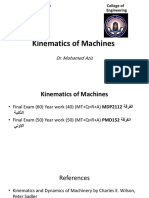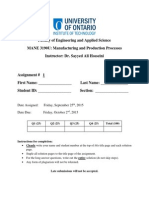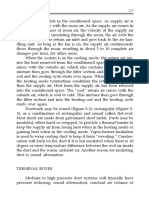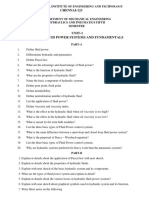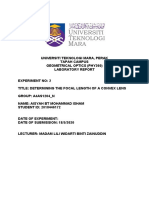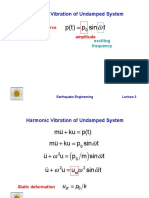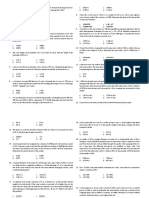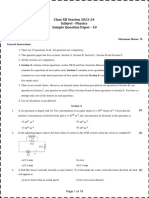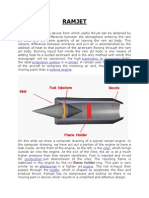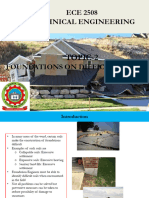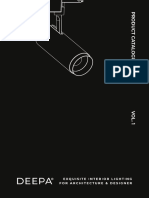Introductory Lecture
Instructor:
Dr. Amir Monjazeb, P. Eng.
Room ENG 1025
Contact: Via Blackboard Messaging system
KINEMATICS AND DYNAMICS OF MACHINES
Kinematics & Dynamics of Machines
MECE 3270U
Introduction -1
�Lectures
Day(s)
Wednesdays
&
Fridays
Time
3:40 5:00
2:10 - 3:30
Location
UP 1500
Tutorials
&
Labs
Check My
Campus
Check My
Campus
Check My
Campus
Office
hours
Tuesdays
and
Thursdays
1:00 3:00
ENG 1025
KINEMATICS AND DYNAMICS OF MACHINES
Schedule
Introduction -2
�Kenneth J. Waldron
and Gary L. Kinzel
Kinematics, Dynamics,
and Design of
Machinery, John Wiley
& Sons, 2004.
KINEMATICS AND DYNAMICS OF MACHINES
Textbook
Introduction -3
� ENGR/MECE
You
2430U Dynamics
must withdraw from this course if you
have not completed the prerequisites
KINEMATICS AND DYNAMICS OF MACHINES
Prerequisites
Introduction -4
�Short Random Quizzes
Assignments
Labs
Project
Midterm
Final Exam (3 hrs)
5% (bonus)
10%
10%
10%
20%
50%
You must pass the final exam in
order to pass the course.
KINEMATICS AND DYNAMICS OF MACHINES
Marking Scheme
Introduction -5
� Each
assignment is divided into two parts:
Part A is to be done during the tutorial
period with the assistance of the TA.
Part B is to be done outside of the tutorial
and is to be handed in on the designated
due date.
Assignments will be due on the dates
assigned.
Late
assignments will not be accepted.
KINEMATICS AND DYNAMICS OF MACHINES
Assignments (individual effort)
Introduction -6
� Cover
Page (typed)
Name:
ID #:
Assignment #:
Present
Free
a Solution
Body Diagrams is Important
Staple
KINEMATICS AND DYNAMICS OF MACHINES
Assignment Format
Introduction -7
� Carefully read lab handout prior to lab so you
will be ready to go to work.
20% of the lab mark will be assigned by the TA
based on your readiness, so come to the lab
prepared.
Bring a hard cover lab notebook.
Record all important details in your notebook
and have it signed by the lab instructor before
leaving the lab.
Prepare a report for each lab.
Hand in your report at lab notes location on the
assigned due dates.
KINEMATICS AND DYNAMICS OF MACHINES
Laboratories
Introduction -8
� Random
10-15
No
min
deferred quizzes
KINEMATICS AND DYNAMICS OF MACHINES
Quizzes
Introduction -9
� Midterm
Saturday, November 1st from 12 to 1:30 pm in
TBA
20%
Final
50%
You need to pass the final in order to pass the
course.
If you do better on the final exam than you do on
the mid-term exam, then the final exam will be
worth 55% and mid-term 15%.
KINEMATICS AND DYNAMICS OF MACHINES
Exams
Introduction -10
�Introduction to mechanisms
Mechanics of rigid bodies
Graphical kinematic analysis
Analytical kinematics
Graphical force analysis
Analytical forces & balancing
Flywheels
Gyroscopic forces
Cams and Gears
Review lectures
KINEMATICS AND DYNAMICS OF MACHINES
Course Outlines
Introduction -11
Kinematic analysis of a quick-return
mechanism.
Dynamic analysis of four-bar quick-return
mechanisms.
Methods for determining centre of mass
and moment of inertia.
Design of a cam-follower system.
Gear trains.
Labs will start on September 23
KINEMATICS AND DYNAMICS OF MACHINES
Laboratories
Introduction -12
�Attend all lectures, tutorials and labs
Read assigned readings, and do the
assignments
Do not leave the lecture room without
understanding (Just ask me)
Try the assignment yourself, if you have
any difficulties come and see me or the
TA
Participate in the lecture and give me
feedback
KINEMATICS AND DYNAMICS OF MACHINES
My Expectations
Introduction -13
�After carefully listening to each lecture
1. Open the problem section at the end of each chapter and try to
understand them
2. As you might not be able to solve many of them, check out the solved
sample problems in the chapter
3. It is time, now, to start reading the chapter and understand key points
and the main concept.
4. Read your lecture notes
5. Go back to problems at the end of the chapter and try to solve them
now
6. Try to find similar examples on the Internet or Youtube.com
7. Get help from TAs
8. Come to my office if you face any difficulties
KINEMATICS AND DYNAMICS OF MACHINES
How can you learn this course effectively?
Slide 14
�With many figures and models from Machines & Mechanisms: Applied
Kinematics, Analysis (David H. Myszka), Kinematics, Dynamics, and Design of
Machinery (Waldron & Kinzel) and from Mechanics of Machines (Cleghorn)
KINEMATICS AND DYNAMICS OF MACHINES
Today, we will cover:
1.
Few definitions
2.
Examples of mechanisms
3.
Joints DOF
4.
Kinematic pairs
5.
Mechanism mobility
Lecture 2 - 15
Kinematics: The study of motion without
regard of force. The objective of kinematics
is to develop various means of transforming
motion to achieve a specific kind needed in
applications.
Dynamics: The study of forces on system in
motion. The objective of dynamics is to
analyse the behaviour of a given machine or
mechanism when subjected to dynamic
forces.
KINEMATICS AND DYNAMICS OF MACHINES
Kinematics & Dynamics
Lecture 2 - 16
� Machine:
an assemblage of parts that
transmit forces, motion and energy in a
predetermined manner.
Mechanical parts
Electrical parts
KINEMATICS AND DYNAMICS OF MACHINES
Machine/Mechanism/Links
Lecture 2 - 17
A machine has two functions:
Transmitting definite relative motion
(motions may be continuous or
intermittent, linear and/or angular)
Transmitting force
These functions require strength and
rigidity to transmit the forces.
KINEMATICS AND DYNAMICS OF MACHINES
Machine
Lecture 2 - 18
Single-cylinder piston engine:
Figure 1.1 Single-cylinder piston engine [Model 1.1].
KINEMATICS AND DYNAMICS OF MACHINES
Machine
Lecture 2 - 19
mechanism may be defined as a
combination of rigid or resistant
bodies, formed and connected so that
they move with definite relative
motions with respect to one another.
A mechanism can also be defined as
an assemblage of rigid members
connected together by joints
KINEMATICS AND DYNAMICS OF MACHINES
Mechanisms
Lecture 2 - 20
� Its
task is to transform both input
forces and movements into a desired
set of out
put forces and movements the an
input force
KINEMATICS AND DYNAMICS OF MACHINES
What Does a Mechanism Do?
Lecture 2 - 21
Mechanisms within single-cylinder engine:
Figure 1.2 Mechanisms in a single-cylinder piston engine: (a) engine, (b) timing belt drive, (c) cam mechanism, (d) slider crank mechanism.
KINEMATICS AND DYNAMICS OF MACHINES
Mechanisms
Lecture 2 - 22
� Individual
parts of a machine or
mechanism are referred to as links:
They may be nonrigid, such as cables
and belts
They may be rigid bodies, such as
cranks, levers, wheels, bars, or gears
KINEMATICS AND DYNAMICS OF MACHINES
Links
Lecture 2 - 23
�empty circles:
pivot points
Figure 1.6 (a) Slider crank mechanism. (b) Skeleton representation.
hatched lines:
base link
KINEMATICS AND DYNAMICS OF MACHINES
Skeleton Representation
(slider-crank)
Lecture 2 - 24
�pivot point
crank
coupler
(connecting rod)
slider
base pivot
base link
Figure 1.7 Slider crank mechanism with offset [Model 1.7].
pivot point
Skeleton diagram
KINEMATICS AND DYNAMICS OF MACHINES
Slider-Crank Mechanism
Lecture 2 - 25
�As link 2 rotates full circle, link
4 only oscillates between ~85
and ~135 degrees
Figure 1.8 (a) Four-bar mechanism [Model 1.8]. (b) Function graph.
KINEMATICS AND DYNAMICS OF MACHINES
Four-Bar Mechanism
Lecture 2 - 26
Mechanisms can be built up by starting with a
single mechanism, then adding links to create
more complicated mechanisms.
Figure 1.12 Washing machine mechanism [Model 1.12].
KINEMATICS AND DYNAMICS OF MACHINES
Four-Bar Mechanism
Lecture 2 - 27
�KINEMATICS AND DYNAMICS OF MACHINES
Four-Bar Mechanism
Figure 1.11 Washing machine mechanism [Model 1.12].
Lecture 2 - 28
�SKELETON: used to show
centre to centre distances
KINEMATICS AND DYNAMICS OF MACHINES
Equivalent Four-Bar Mechanisms
Figure 1.10 Equivalent four-bar mechanisms [Video 1.10].
Lecture 2 - 29
�KINEMATICS AND DYNAMICS OF MACHINES
Equivalent Four-Bar Mechanisms
Figure 1.10 Equivalent four-bar mechanisms [Video 1.10]. (Continued)
Lecture 2 - 30
link is defined as a machine element
(component) having two or more nodes
(pairing elements) which connect it to other
bodies for the purpose of transmitting force
or motion.
KINEMATICS AND DYNAMICS OF MACHINES
Link
Lecture 2 - 31
�Not rigid elements
Spring
Belts
Ropes
KINEMATICS AND DYNAMICS OF MACHINES
Link (completely rigid)
Crank Pin
Crank Shaft
Flywheel
Lecture 2 - 32
�Link has two nodes
Binary
Ternary
Binary
Link hasTernary
three nodes
Binary
Ternary
Quaternary
Quaternary
LinkTernary
has four nodes
Quaternary
Quaternary
KINEMATICS AND DYNAMICS OF MACHINES
Binary
Lecture 2 - 33
� The
links of a mechanism are connected
together by kinematics pairs (or joints).
Each kinematic pair permits only one
relative motion between adjacent links:
Turning Pairs
Sliding Pairs
Rolling Pairs
KINEMATICS AND DYNAMICS OF MACHINES
Kinematic Pairs
Lecture 2 - 34
�Figure 1.31 Examples of turning pairs.
KINEMATICS AND DYNAMICS OF MACHINES
Examples of Turning Pairs
Lecture 2 - 35
�Figure 1.32 Examples of sliding pairs.
KINEMATICS AND DYNAMICS OF MACHINES
Examples of Sliding Pairs
Lecture 2 - 36
�Degrees of Freedom (dof) The number of
independent coordinates required to
define/constrain the position of all links with
respect to ground.
xG
Rigid link has 3
DOF (in-plane)
yG
KINEMATICS AND DYNAMICS OF MACHINES
Degrees of Freedom
Lecture 2 - 37
� Simple
motion
Pure translation
Pure rotation
Complex
motion: simultaneous
combination of translation and rotation
KINEMATICS AND DYNAMICS OF MACHINES
Types of Motion
Lecture 2 - 38
� Pin
joint allows 1 DOF
Linear slider
Threaded nut
Tire on dry ground
KINEMATICS AND DYNAMICS OF MACHINES
1 DOF Pairs (Joints)
Lecture 2 - 39
�KINEMATICS AND DYNAMICS OF MACHINES
2 DOF Pairs (Joints)
Lecture 2 - 40
� Lower
(primary) pairs - Single degree of
freedom
Higher
pairs - Two degrees of freedom
KINEMATICS AND DYNAMICS OF MACHINES
Joint Nomenclature
Lecture 2 - 41
� The
mobility of a mechanism is defined
as the minimum number of independent
parameters (coordinates) required to
specify the position of all links of the
mechanism.
= +
=
n = number of links
j = number of joints
KINEMATICS AND DYNAMICS OF MACHINES
Mechanism Mobility
fi = degrees of freedom of relative joints
Chapter 2 - 42
= +
Figure 1.36 Examples of mobility.
KINEMATICS AND DYNAMICS OF MACHINES
Examples of Mobility (1)
Lecture 2 - 43
�Front-end loader (model)
n=?
j=?
fi = ?
M=2
KINEMATICS AND DYNAMICS OF MACHINES
Examples of Mobility (2)
Lecture 2 - 44
� Mobility
of spatial mechanisms
Mechanism Inversion
Grashof criterion
Examples
KINEMATICS AND DYNAMICS OF MACHINES
Next Lecture
Lecture 2 - 45



